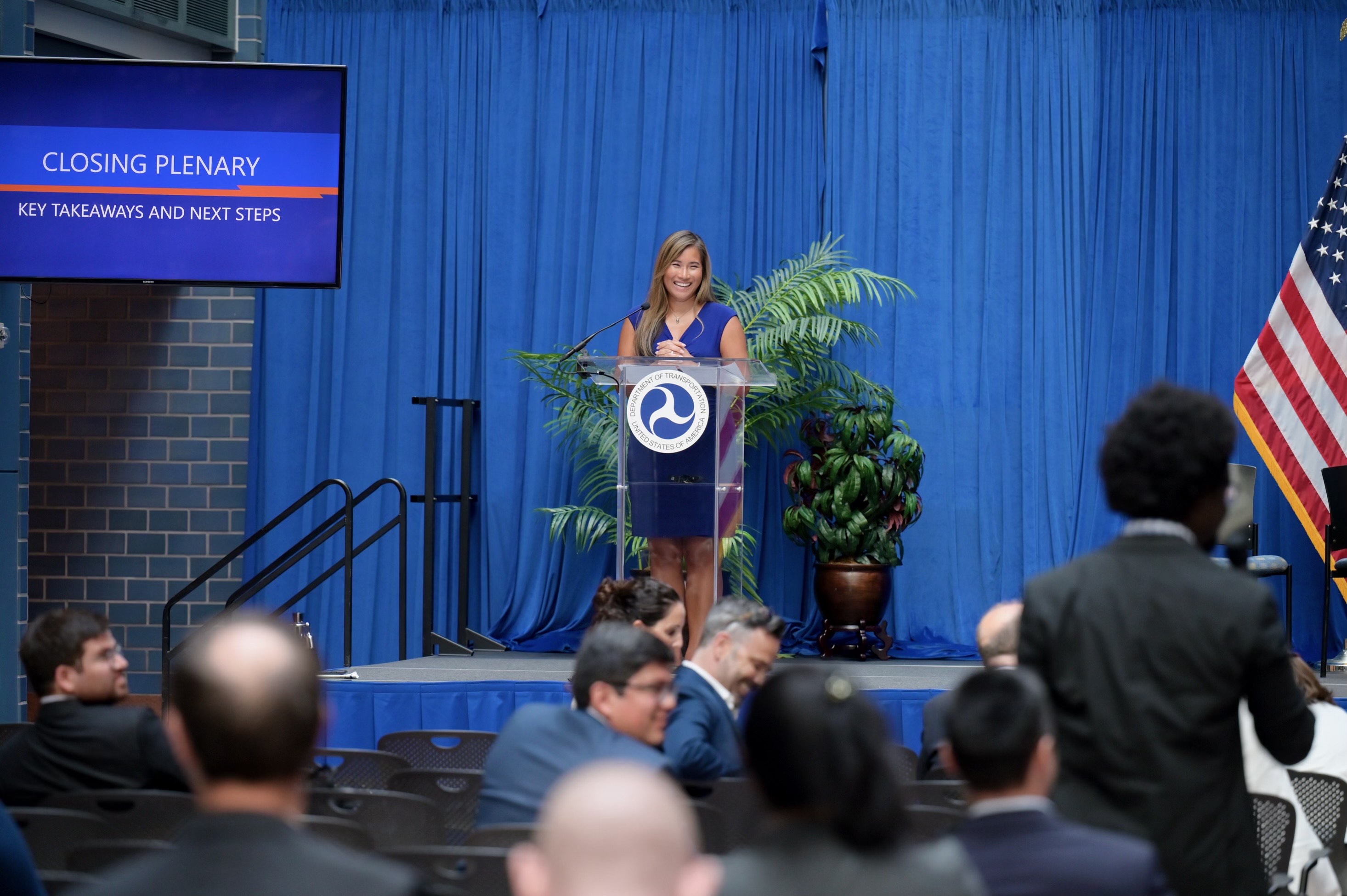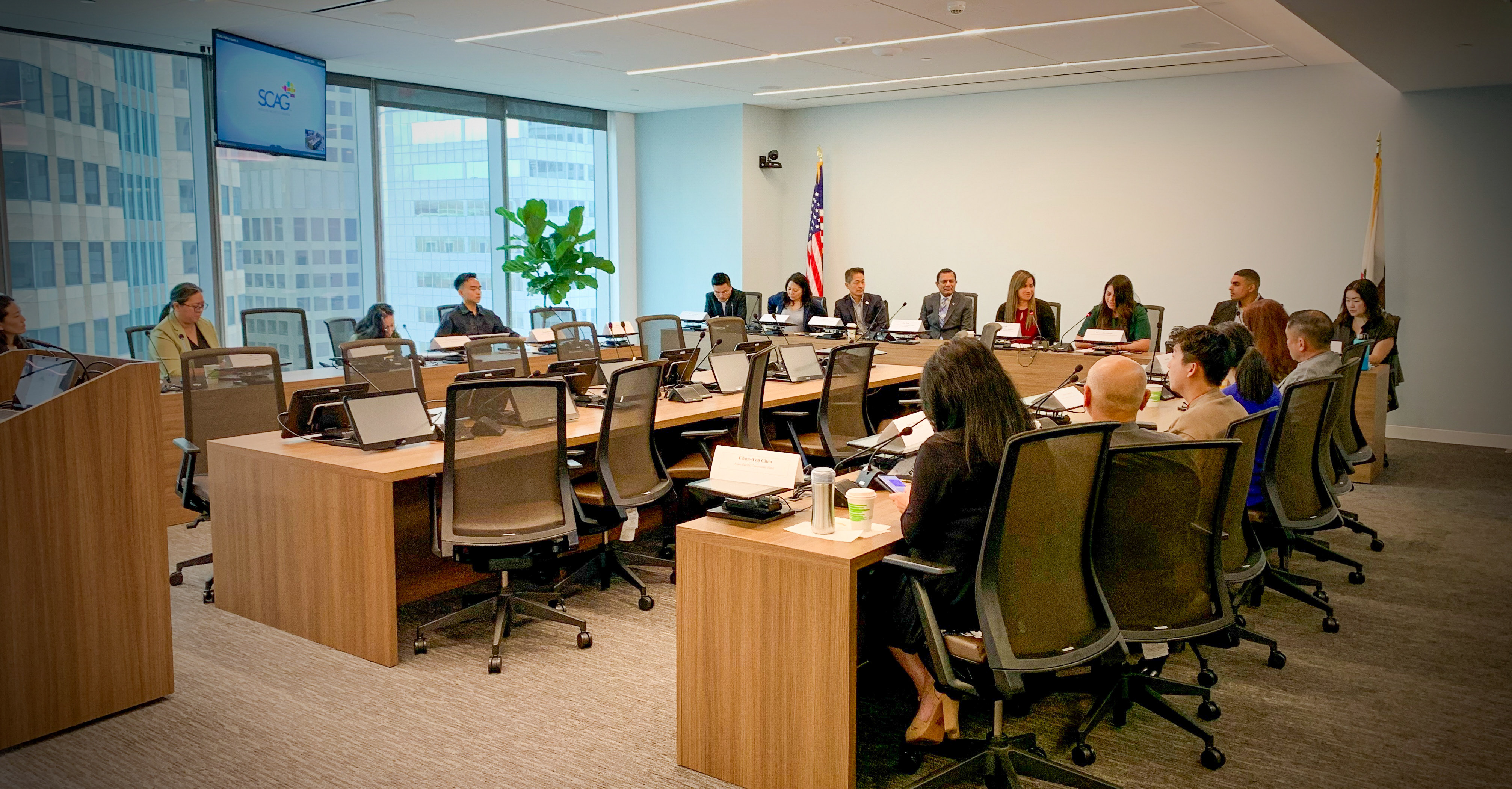Transit California sat down with Lynda Tran, CEO of Lincoln Room Strategies, former Senior Advisor to the U.S. Transportation Secretary and one of our two Keynote Speakers at our Annual Fall Conference & Expo.

Transit California: You are the CEO of Lincoln Room Strategies, a Washington, DC-based firm which supports transportation sector clients whose work is affected by the federal regulatory and grant environment. Where are you seeing challenges in 2025 and beyond, and where are there opportunities for public transit?
It was the honor of a lifetime to serve at the US Department of Transportation at a time when we were designing and implementing the greatest investment in transportation and infrastructure in a generation. And the Biden Administration was able to award about 95% of the resources approved by Congress under the Infrastructure Investment and Jobs Act (the Bipartisan Infrastructure Law), the Inflation Reduction Act, and the CHIPS Act before handing off the baton this January. I’m deeply proud to have been part of the team to deliver on these commitments to the American people, and I believe those investments will continue to reap benefits for communities across the country for decades to come.
That said, the transition from the last Administration to the current one has not been without challenges – real or perceived – from stakeholders nationally. Changes and uncertainty around the grantmaking process – including awards that were previously announced to support the development of high speed rail and other investments – are definitely having ripple effects across the project delivery ecosystem. The same is true for the widely reported reductions in the workforce – including an estimated 7% across USDOT and 28% within FTA alone – that may have a significant impact on the efficiency and speed of program delivery, regulatory accountability, and future awards.
I’m also concerned that the demonization of diversity and inclusion initiatives – which have sought to level the playing field and inject equity into various facets of the transportation sector that have historically disproportionately impacted certain communities will take us back a generation or more.
But I could not have survived the last three decades working in policy and politics if I were not an eternal optimist – and I see reason to continue to be optimistic in the years ahead. For starters, this administration has made clear it is prioritizing innovation and is supportive of industry and agency efforts to make significant technological leaps – that means opportunities in public transportation – I’m thinking of Alameda County in CA and Jacksonville in FL as some examples where agency leaders are experimenting with new ways of moving people and expanding job training and upskilling the workforce which will hopefully mean more collaborations with local schools, more apprenticeship programs, and better paying jobs for operators, mechanics, and others.
I also see permitting reforms and speeding project delivery at a time when we are still benefiting from the historic investments made possible by President Biden’s Bipartisan Infrastructure Law as good for all so long as those efforts don’t turn a blind eye to environmental and community impacts.
Lastly there are always opportunities to advance safety, improve passenger experience, and increase ridership – I expect more investment in low and no-emissions buses, facilities, more resources for mobility and accessibility, and a continued interest in the overall connectivity of the transportation system to help keep communities moving and connecting people to jobs and economic opportunity. Transportation should not be partisan and I’m optimistic we can continue to make meaningful progress.
Transit California: When you served as Senior Advisor to U.S. Transportation Secretary Pete Buttigieg and Director of Public Engagement for the U.S. Department of Transportation (DOT), you were an important part of the leadership team that secured passage of the $1.2 trillion Infrastructure Investment and Jobs Act (IIJA), also known as the Bipartisan Infrastructure Law. What major lessons did you learn from your work on that effort?
I feel strongly that transportation policy is inherently economic policy and is really non-partisan in nature – if we agree on nothing else, we should at least agree that mobility and accessibility are human rights, and an effective transportation system is critical to connecting people to jobs and economic opportunity so our communities can thrive.
What I found during my tenure at USDOT was there is a broad and committed coalition of stakeholders who recognize that until the Bipartisan Infrastructure Law we had failed to invest in infrastructure for the last 50 years to the detriment of our ability to compete as a nation. That wide array of groups, leaders, and individuals who were willing to fight for the Bipartisan Infrastructure Law remain ready to fight for more resources. It remains incumbent on all of us to keep pushing for what communities need because our economic future depends on it.
Secondly, if you want to build and maintain the coalition, it takes more than announcing a “national infrastructure week;” it takes listening to the ideas, concerns, feedback from a diverse set of stakeholders, and importantly, being responsive to that information. We design better programs and deliver the best outcomes when we benefit from that collective knowledge and local, lived experience rather than expecting a one-size-fits all approach to solve the big challenges facing our communities.
Finally, even when you win, you can’t expect to keep winning – so you have to make the absolute most of the time and resources you have. That infusion may not come again with the same focus or fervor in the near future.
Transit California: You served as DOT’s official designee to the White House Initiative on Asian Americans, Native Hawai’ians and Pacific Islanders. From your perspective, as an industry how are we doing when it comes to progress in the DEI space, and where can we as an industry lean in more on areas of diversity and inclusion?
 One of the best experiences I had in the last Administration was serving as Cabinet Designee to the White House Initiative on Asian Americans, Native Hawai’ians and Pacific Islanders, which was first established by then-President Bill Clinton in 1999 to advance equity, justice, and economic opportunity for AA and NHPI communities and re-established with every subsequent Administration until this one. The honor was especially significant in the wake of the COVID-19 pandemic and the rise in hate crimes and acts of discrimination targeting AA and NHPI people nationally – especially on public transportation.
One of the best experiences I had in the last Administration was serving as Cabinet Designee to the White House Initiative on Asian Americans, Native Hawai’ians and Pacific Islanders, which was first established by then-President Bill Clinton in 1999 to advance equity, justice, and economic opportunity for AA and NHPI communities and re-established with every subsequent Administration until this one. The honor was especially significant in the wake of the COVID-19 pandemic and the rise in hate crimes and acts of discrimination targeting AA and NHPI people nationally – especially on public transportation.
What I found as I traveled the country to meet with stakeholders and elected leaders was a hunger to share intel on everything from transit safety to language accessibility to ideas for promoting public transportation and expand ridership in the post-COVID era. People had recommendations about everything from better wayfinding to “upstander’ training (as opposed to being a bystander) and shared their experiences at the lowest and at peak ridership times.
While budgets and resources are paramount, I think awareness of the challenges and a desire to make improvements is half the battle. If we want to build on the gains we have made in recent years, we need to see continued commitment from the sector – investing in leaders from diverse backgrounds, systems and services that uplift and account for the mosaic fabric of our communities, and the broader application of communications that are more responsive to differences in culture and accommodating to the passengers we serve.
Transit California: You have a seat on the Board of Trustees at the Mineta Transportation Institute, which is advising about the likely consequences of ongoing and additional proposed federal funding cuts to public transit. How are you and the board moving forward under these circumstances?
There is no doubt these are more uncertain times – but for the most part we have not seen the concerns whispered about behind closed doors come to fruition. We have to continue to apply for existing resources given the ground rules and the landscape we face today.
We also need to leverage the moment to explore resourcing and additional partners where we can – in CA that may mean looking to the state legislature and state leaders for support and to be part of the solution, and it may mean reminding external organizations and private industry they have an enormous economic stake in whether we invest in the public transportation their constituents and employees rely on.
Transit California: You also sit on the Board of Directors for Main Street America, a national network with a mission of improving quality of life in America’s downtowns and neighborhood commercial districts. What does success for transit look like in these neighborhoods?
For those who may be less familiar with Main Street America, think of the organization as a grassroots network of 2,900 communities working to revitalize their main streets and expand economic opportunity. All of these communities share common challenges but have local problems they are working to solve that reflect their unique histories. It stands to reason that their vision for public transportation is also varied – where bus rapid transit makes sense in one community, another may prioritize improvements to existing rail lines.
That variety is part of what make transportation exciting and interesting. At the end of the day it is always about ensuring we can connect residents to jobs and support a vibrant downtown that grows the local economy.
Transit California: You served as a director of communications for the National Highway Traffic Safety Administration at US DOT. What were some lessons you learned about successfully communicating to the public in a transit-affecting crisis?
During my tenure at NHTSA our work was quite squarely centered on private vehicles and the early move from internal combustion engine vehicles to electric vehicles. While we dealt with communications challenges including EV fires and unintended acceleration, they were not really about the overlay with transit.
In my most recent role, we saw how automated vehicles could impact public transportation in the event of vehicle failures – think San Francisco. As we continue to see significant leaps in technology such as vehicle automation that can dramatically improve the lives of ordinary folks and improve roadway safety overall, the lesson is really to keep all interested parties in regular communication with federal, state, and local leaders and to align on any potential impacts to public safety – without clinging to the status quo.
Big picture, the best thing to do in a crisis is not to jump to conclusions, to be committed to a data-driven and fact-based analysis of the situation, and to remain calm and measured in your external communications.
Transit California: The national Conference of Minority Transportation Officials (COMTO) acknowledged your important contributions to transit with an Industry Award. How can transit agencies best support women of color in transit leadership?
To this day, it was still one of the most moving experiences of my career to be honored by COMTO as a “Woman Who Moves the Nation.” I have never cried at the microphone before! To be in that room with hundreds of colleagues at every level of leadership across the country and to feel the shared pride and support, to be able to acknowledge the challenges and the sacrifices made by my own family over the years – I will never forget it. It meant a lot to me to be able to tell my personal story and two years later I am still meeting women of color who were in the room who tell me my candor and emotion inspired them.
Now more than ever I think it is important to recognize the achievements of women of color and the need to keep improving opportunities. It starts with storytelling and uplifting people who have faced down challenges to get where they are today – and it continues with executing policies and programs that make it easier for the next generation to get there. The work continues.
Transit California: The Association recently announced that you will be a keynote speaker at our 60th Annual Fall Conference and Expo from November 5-7 (register here). Can you give our readers and interested attendees a preview of your discussion?
I am an open book and I pride myself on an “Ask Me Anything” environment. I am also a community organizer at heart – so you can expect a Call to Action.